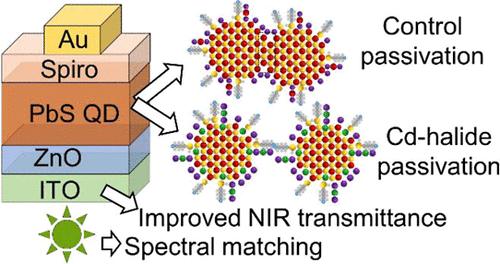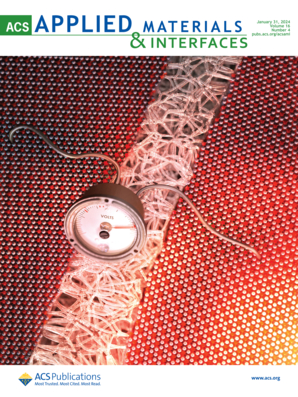Synergistic Improvement of Narrow Bandgap PbS Quantum Dot Solar Cells through Surface Ligand Engineering, Near-Infrared Spectral Matching, and Enhanced Electrode Transparency
IF 8.3
2区 材料科学
Q1 MATERIALS SCIENCE, MULTIDISCIPLINARY
引用次数: 0
Abstract
The tunability of the energy bandgap in the near-infrared (NIR) range uniquely positions colloidal lead sulfide (PbS) quantum dots (QDs) as a versatile material to enhance the performance of existing perovskite and silicon solar cells in tandem architectures. The desired narrow bandgap (NBG) PbS QDs exhibit polar (111) and nonpolar (100) terminal facets, making effective surface passivation through ligand engineering highly challenging. Despite recent breakthroughs in surface ligand engineering, NBG PbS QDs suffer from uncontrolled agglomeration in solid films, leading to increased energy disorder and trap formation. The limited NIR transparency of commonly used indium-doped tin oxide (ITO) electrodes and inadequate NIR radiation from commercially available solar simulators further compromise the true performance of NBG PbS QDs in solar cells. Here, we employ a hybrid ligand strategy based on inorganic cadmium halide and organic thiol molecules, leading to the partial substitution of surface Pb atoms with Cd heteroatoms. This hybrid ligand strategy substantially reduces undesired QD fusion in solid films, improving the photophysical and electronic properties. By modulating the thickness of the ITO layer and managing refraction loss through a ZnO layer coating, we improved NIR transparency to above 80%. We combine an NIR light source with a solar simulator to achieve near-ideal spectral matching for a broader range with standard AM1.5G illumination. Enhancements in surface passivation of QDs, improvements in NIR transparency of electrodes, and a spectral matched light source setup help us achieve solar cell power conversion efficiencies of 12.4%, 4.48%, and 1.37% under AM 1.5G, perovskite filter, and silicon filter illuminations, respectively. A record open-circuit voltage (Voc) of 0.54 V and short-circuit current density (Jsc) of 38.5 mA/cm2 are achieved under AM 1.5G illumination. We attribute these advancements in photovoltaic parameters to the reduction in Urbach tail states and intermediate trap density originating from superior surface passivation of QDs.

通过表面配体工程、近红外光谱匹配和增强电极透明度协同改进窄带隙PbS量子点太阳能电池
近红外(NIR)范围内能量带隙的可调性使胶体硫化铅(PbS)量子点(QDs)成为一种通用材料,可以提高现有钙钛矿和硅太阳能电池串联结构的性能。窄带隙(NBG) PbS量子点具有极性(111)和非极性(100)端面,这使得通过配体工程实现有效的表面钝化非常具有挑战性。尽管近年来在表面配体工程方面取得了突破,但NBG PbS量子点在固体薄膜中存在不受控制的团聚,导致能量无序增加和陷阱形成。常用的铟掺杂氧化锡(ITO)电极的近红外透明度有限,以及商用太阳模拟器的近红外辐射不足,进一步损害了NBG PbS量子点在太阳能电池中的真实性能。在这里,我们采用了一种基于无机卤化镉和有机硫醇分子的杂化配体策略,导致表面Pb原子部分取代Cd杂原子。这种混合配体策略大大减少了固体薄膜中不希望的量子点融合,改善了光物理和电子性能。通过调制ITO层的厚度和通过ZnO层涂层控制折射损失,我们将近红外透明度提高到80%以上。我们将近红外光源与太阳模拟器相结合,在标准AM1.5G照明的情况下,在更广泛的范围内实现接近理想的光谱匹配。量子点表面钝化的增强、电极近红外透明度的提高以及光谱匹配的光源设置帮助我们在AM 1.5G、钙钛矿滤光片和硅滤光片照明下分别实现了12.4%、4.48%和1.37%的太阳能电池功率转换效率。在AM 1.5G照明下,实现了0.54 V的开路电压(Voc)和38.5 mA/cm2的短路电流密度(Jsc)。我们将这些光伏参数的进步归因于量子点表面钝化导致的乌尔巴赫尾态和中间陷阱密度的减少。
本文章由计算机程序翻译,如有差异,请以英文原文为准。
求助全文
约1分钟内获得全文
求助全文
来源期刊

ACS Applied Materials & Interfaces
工程技术-材料科学:综合
CiteScore
16.00
自引率
6.30%
发文量
4978
审稿时长
1.8 months
期刊介绍:
ACS Applied Materials & Interfaces is a leading interdisciplinary journal that brings together chemists, engineers, physicists, and biologists to explore the development and utilization of newly-discovered materials and interfacial processes for specific applications. Our journal has experienced remarkable growth since its establishment in 2009, both in terms of the number of articles published and the impact of the research showcased. We are proud to foster a truly global community, with the majority of published articles originating from outside the United States, reflecting the rapid growth of applied research worldwide.
 求助内容:
求助内容: 应助结果提醒方式:
应助结果提醒方式:


